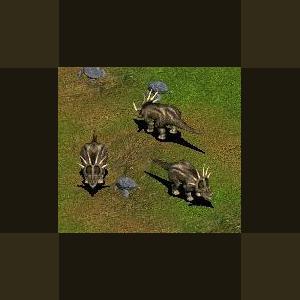About This File
Einiosaurus
Einiosaurus is a medium-sized centrosaurine (“short-frilled”) ceratopsian from the Upper Cretaceous (Campanian) Two Medicine Formation of northwestern Montana. The generic epithet means 'buffalo lizard', in a combination of Blackfeet Indian and Latinized Ancient Greek and the specific epithet means 'forward-curving horn' in Latin and Ancient Greek.
Einiosaurus was a herbivorous dinosaur and grew to 6 meters in length. It is typically portrayed with a low, strongly forward-curving nasal horn that resembles a bottle opener, though this may only occur in some adults. Supraorbital (over-the-eye) horns are low and rounded if present at all, as opposed to ceratopsids with prominent supraorbital horns such as Triceratops. A pair of large spikes projects backwards from the relatively small frill.
Low-diversity and single-species bonebeds are thought to represent herds that may have died in catastrophic events, such as during a drought or flood. This is evidence that Einiosaurus, as well as other centrosaurine ceratopsians such as Pachyrhinosaurus and Centrosaurus, were herding animals similar in behavior to modern-day bison or wildebeest. In contrast, ceratopsine (“long-frilled”) ceratopsids, such as Triceratops and Torosaurus, are typically found singly, implying that they may have been somewhat solitary in life, though fossilized footprints may provide evidence to the contrary.
Like all ceratopsids, Einiosaurus had a complex dental battery capable of processing even the toughest plants.
Einiosaurus fossils are found in the upper part of the Two Medicine Formation of Montana, dating to the mid-late Campanian stage of the late Cretaceous Period, about 75-70 million years ago. Dinosaurs that lived alongside Einiosaurus include the basal ornithopod Orodromeus, hadrosaurids (such as Hypacrosaurus, Maiasaura, and Prosaurolophus), the ankylosaurs Edmontonia and Euoplocephalus, the tyrannosaurid Daspletosaurus (which appears to have been a specialist of preying on ceratopsians), as well as the smaller theropods Bambiraptor, Chirostenotes, Troodon, and Avisaurus. It also shared its habitat with other ceratopsids: Brachyceratops and Achelosaurus. Einiosaurus lived in a climate that was seasonal, warm, and semi-arid. Other fossils found with the Einiosaurus material include freshwater bivalves and gastropods, which imply that these bones were deposited in a shallow lake environment.
Einiosaurus is an exclusively Montanan dinosaur, and all its known remains are currently held at the Museum of the Rockies in Bozeman, Montana. At least 15 individuals of varying ages are represented by three adult skulls and hundreds of other bones from two low-diversity (in species) bonebeds, which were discovered by Jack Horner in 1985 and excavated from 1985 - 1989 by Museum of the Rockies field crews. These bonebeds were originally thought to contain a new species of Styracosaurus and are referred to as such in the comprehensive taphonomic study by Ray Rogers. In 1995 Scott D. Sampson formally described and named Einiosaurus procurvicornis from this material, as well as Achelousaurus horneri, also from a bonebed in this region.
The placement of Einiosaurus within Centrosaurinae is problematic due to the transitional nature of several of its skull characters, and its closest relatives are either Centrosaurus and Styracosaurus or Achelousaurus and Pachyrhinosaurus. The latter hypothesis is supported by Horner and colleagues, where Einiosaurus is the earliest of an evolutionary series in which the nasal horns gradually change to rough bosses, as in Achelousaurus and Pachyrhinosaurus which are the second and third in this series. The frills also grow in complexity.
Regardless of which hypothesis is correct, Einiosaurus appears to occupy an intermediate position with respect to the evolution of the centrosaurines.



Recommended Comments
There are no comments to display.
Create an account or sign in to comment
You need to be a member in order to leave a comment
Create an account
Sign up for a new account in our community. It's easy!
Register a new accountSign in
Already have an account? Sign in here.
Sign In Now